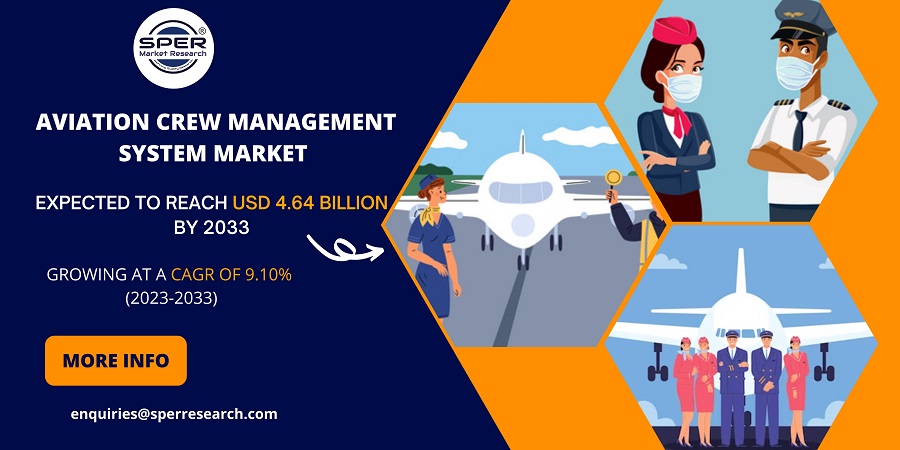An Aviation Crew Management System is a software platform that efficiently plans, schedules, and tracks airline crew members’ assignments, ensuring regulatory compliance, crew safety, and operational efficiency. The technology increases operating efficiency, lowers costs, and promotes worker safety and well-being by simplifying crew-related operations. To allocate the correct crew to certain flights, the platform examines crew availability, duty time constraints, rest intervals, and other considerations. Overall, the Aviation Crew Management System is vital to the proper operation of the aviation sector.
According to SPER market research, ‘Aviation Crew Management System Market Size- By Solution, By Deployment, By Device, By Application – Regional Outlook, Competitive Strategies and Segment Forecast to 2033’ state that the Aviation Crew Management System Market is predicted to reach USD 4.64 billion by 2033 with a CAGR of 9.10%.
Airlines benefit from a variety of aviation crew management systems. They allow for effective crew resource optimisation by matching staff availability and qualifications to flight schedules, lowering costs and assuring timely availability. The incorporation of sophisticated technologies such as AI, machine learning, and data analytics improves system capabilities by facilitating data-driven decision-making and operational efficiency benefits. These technologies also help to cut costs by optimising worker scheduling, training, and overtime costs. As airlines develop and recover from the COVID-19 epidemic, crew management systems become critical instruments for dealing with complexity and maintaining profitability throughout the industry’s growth period.
Crew management systems face challenges in accommodating crew members’ individual preferences for schedules and optimizing operational efficiency. They must also adapt swiftly to real-time changes and disruptions like flight delays, cancellations, and crew sickness, ensuring prompt replacements and adjustments. The successful implementation of new systems requires overcoming crew resistance through comprehensive training and smooth user adoption. Ensuring the security and privacy of sensitive data stored in these systems is critical to prevent potential consequences of data breaches. Additionally, crew management systems must be scalable and perform well to handle increasing data and user interactions as airlines grow and expand their operations.
Request For Free Sample Report @ https://www.sperresearch.com/report-store/aviation-crew-management-system-market.aspx?sample=1
The COVID-19 pandemic posed various difficulties and adjustments to the market for aircraft crew management systems. Due to frequent travel limitations and border closures, dynamic scheduling problems occurred, demanding real-time modifications to crew management systems. Health and safety procedures necessitated extra personnel training and certifications, necessitating modifications to crew management systems to keep track of these needs. Remote work practises were promoted, causing crew management systems to be modified to allow for remote access and cooperation. Airlines’ financial restrictions hampered market expansion by deferring investments in new crew management systems. The epidemic hastened the transition to cloud-based technologies for more flexibility and scalability. In crew management, crisis management elements have become critical for swift reactions to unanticipated incidents.
Geographically, North America emerged as the dominant region in the Aviation Crew Management System Market. This growth is owing to the presence of key OEMs in the area, as well as the adoption of aviation crew management systems in North America due to benefits such as scalability, efficiency, and cost savings. Furthermore, during the projected period Asia Pacific is predicted to be the fastest expanding region. The increasing modernisation of aviation infrastructure and the expansion of cloud-based services are driving market growth in this area. Additionally, some of the market key players are Jeppesen, Lufthansa Systems, Sabre Corporation, IBS Software, Others
Aviation Crew Management System Market Key Segments Covered
The SPER Market Research report seeks to give market dynamics, demand, and supply forecasts for the years up to 2033. This report contains statistics on product type segment growth estimates and forecasts.
By Solution: Based on the Solution, Global Aviation Crew Management System Market is segmented as; Hardware, Services, Software.
By Deployment: Based on the Deployment, Global Aviation Crew Management System Market is segmented as; Cloud-based, On-premise.
By Device: Based on the Device, Global Aviation Crew Management System Market is segmented as; PCS, Smartphones, Tablets.
By Application: Based on the Application, Global Aviation Crew Management System Market is segmented as; Crew Operations, Crew Planning, Crew Services, Crew Tracking, Crew Training.
By Region: This research also includes data for Middle East and Africa, Asia-Pacific, Latin America, Europe, North America
For More Information, refer to below link:-
Aviation Crew Management System Market Research Report
Related Reports:
Follow Us –
LinkedIn | Instagram | Facebook | Twitter
Contact Us:
Sara Lopes, Business Consultant – USA
SPER Market Research
+1-347-460-289974



